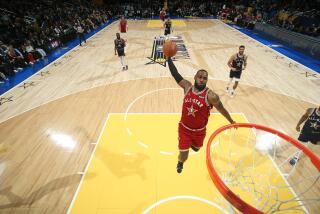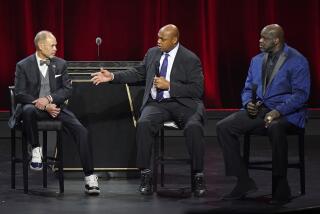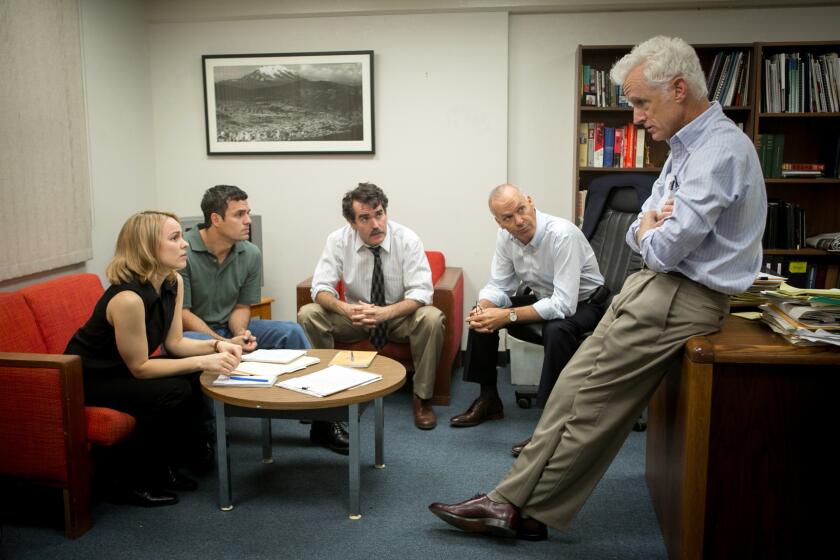ESPN pushes 3-D TV with Consumer Electronics Show sports events
The Consumer Electronics Show’s exhibitors have long employed lavish parties, Hollywood star power and Las Vegas headliners to draw attention to a new technology.
Seldom, however, has a promotion involved organized fisticuffs.
ESPN, Walt Disney Co.’s dominant sports network, put on the gloves — literally — in its promotion of 3-D television by staging a series of boxing matches in the center of the annual event’s exhibit hall Thursday at the Las Vegas Convention Center. The CES edition of its “Friday Night Fights” program caps a week of technology showcases that included a 3-D broadcast of college football’s Bowl Championship Series title game and a live segment of ESPN’s “SportsNation” program.
Network executives hope such high-profile displays will ignite consumer enthusiasm for 3-D TVs, whose initial sales have failed to match manufacturers’ heady expectations. Live sports broadcasts played a significant role in spurring consumer adoption of an earlier television technology — high-definition TVs.
“The number of screens on shelves and in homes with 3-D capabilities continues to grow,” said Bryan Burns, ESPN’s vice president of strategic business planning. “It’s incumbent upon us to demonstrate how these screens showcase and complement our content.”
The success of James Cameron’s 2009 science-fiction 3-D movie “Avatar,” the highest-grossing film of all time with $2.8 billion in global ticket sales, encouraged television manufacturers to begin heavily promoting 3-D TVs to consumers in 2010. Several manufacturers projected that sales would reach 4 million units in the U.S. alone for that year, industry analysts said.
However, shipments reached only 1.2 million in 2010, according to the Consumer Electronics Assn., a trade group. That was more than double the 2009 figure but still short of manufacturers’ projections.
“Manufacturers really played up the success of 3-D in theaters as leading to an enthusiastic response at home,” said Paul Gagnon of research firm DisplaySearch. “That was the intent — to take advantage of the buzz around a film like ‘Avatar.’”
But the initial 3-D TV sets were sold at a premium of as much as 50% over other televisions of comparable size. A 47-inch 3-D TV sold for $1,544, compared with the average price of about $1,000 for an HDTV of the same size, according to DisplaySearch.
Meanwhile, some consumers mistakenly believed that they would be limited to watching only 3-D programs on the new sets. Others expressed qualms about the need to wear polarized glasses to watch movies in their own homes.
“It was a little bit of a disaster,” Gagnon said.
TV manufacturers shifted their marketing last year, touting 3-D as a feature of high-end sets that also included other attributes, such as Internet connectivity. U.S. shipments rose to 3.6 million TVs last year, and are projected to reach nearly 7 million in 2012, according to the industry’s estimates.
ESPN, which has telecast more than 180 sporting events in 3-D, chose to demonstrate its immense potential to a crowd that included passionate early technology adopters. About 750 people donned 3-D glasses at a live broadcast Monday night of the college football championship game, as viewers watched Alabama defeat LSU, 21-0, on a movie-theater-size screen.
“You can get the total feel of what it’s like,” said Lonnie Larson of Iola, Kan., who said the 3-D broadcast of the championship game was so realistic that he felt as if he were on the field alongside the players.
The live boxing matches in ESPN’s booth at CES drew so many spectators that they required crowd control. The matches attracted some notable sports figures, including professional boxer Nonito Donaire and Rita Benson LeBlanc, owner of the New Orleans Saints football team.
LeBlanc said 3-D technology enables the fans to get as close as possible to the action. “We’re constantly looking to enhance the experience,” she said.
Onlookers like Lanny Burdick of Shawnee, Kan., described the viewing experience as “unbelievable.” He said he was particularly drawn to the 3-D replays shown on flat-panel screens surrounding the boxing ring. Burdick said he thought that 3-D heightened the drama of key moments in the fights, as when Saul Rodriguez knocked out Henry “The Real Deal” Hernandez.
“It was so graphic to see that second punch as [Hernandez] was going down,” Burdick said. “It certainly brings you closer.”
Burdick said he would probably wait until more 3-D content is available, though, before investing in a 3-D TV.
Hampton Adams, head of the research department and portfolio manager for the Pasadena investment firm Gamble Jones, predicted that consumer adoption of 3-D TV sets is likely to be slow because so many consumers have already replaced their bulky analog TVs with flat-panel HDTVs. About 72% of U.S. homes now have an HDTV, according to the industry, which predicts that number should rise to 87% by year-end.
“There’s been a big upgrade cycle where people went from analog to high-definition TVs,” Adams said. The adoption of 3-D TV will happen, he said, “but it’ll take a while.”






